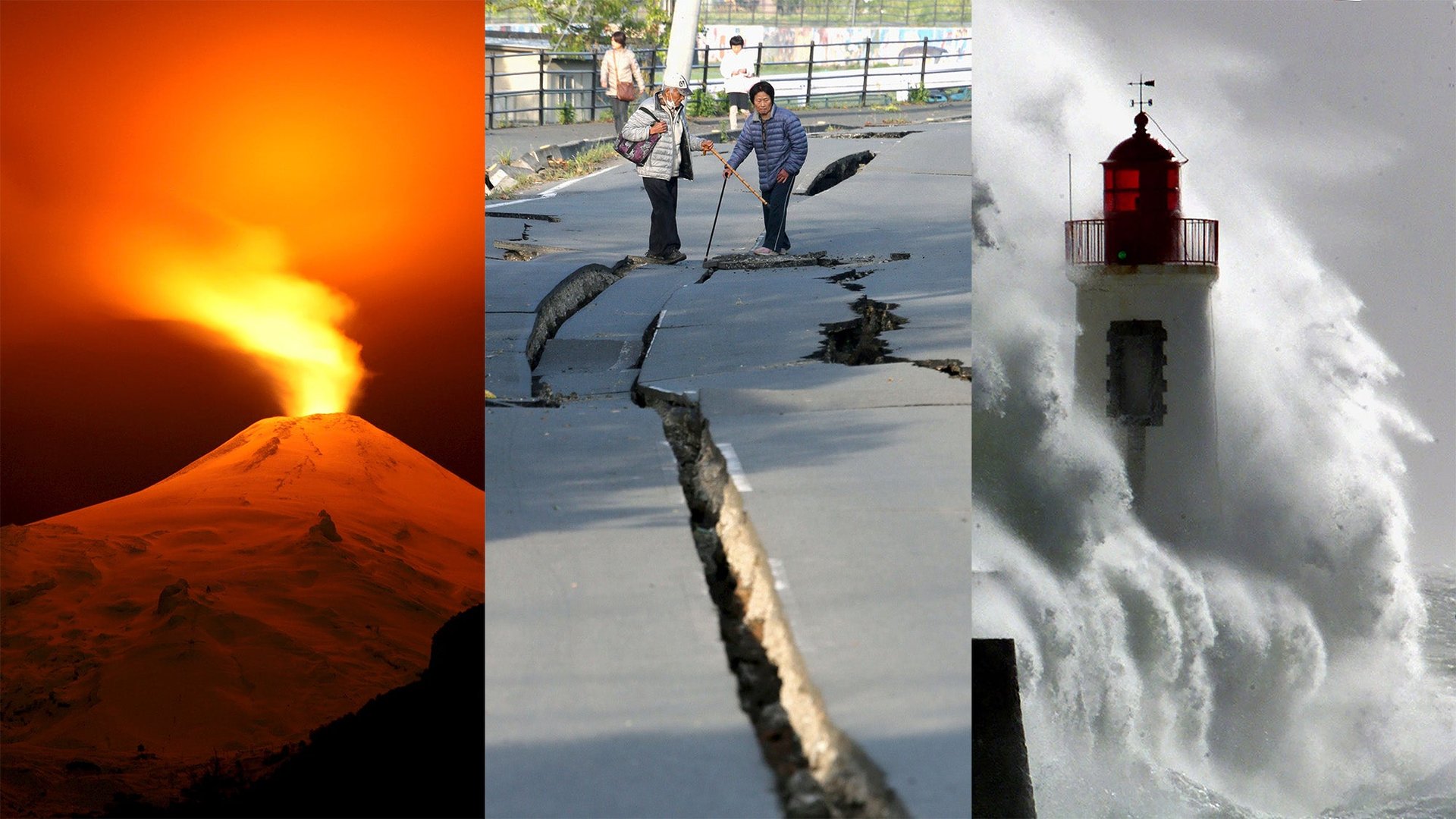Global warming won’t just change the weather—it could trigger massive earthquakes and volcanoes
Bill McGuire is not optimistic about humanity’s future. In his book, Waking the Giant: How a changing climate triggers earthquakes, tsunamis, and volcanoes, he explains why.


Bill McGuire is not optimistic about humanity’s future. In his book, Waking the Giant: How a changing climate triggers earthquakes, tsunamis, and volcanoes, he explains why.
By his estimation, carbon dioxide emissions from human activity since industrialization began have changed the trajectory of earth’s climate for the next 100,000 years. We are already experiencing the mayhem and destruction that these changes can wreak, and, in the long term, things are only going to get worse.
On the face of it, the hypothesis that a few degrees’ rise in the average temperature of the atmosphere can cause the earth’s tectonic plates to move sounds ludicrous. Yet, McGuire, professor of geophysical and climate hazards at University College London, shows through careful analysis of historical records that the relationship between the weather and the “solid” earth is incontrovertible.
We caught up with him recently to talk about his hopes and fears. Here’s an edited and condensed version of our conversation.
Quartz: How is that human activities in the last two centuries could have an effect on the earth’s climate for the next 100,000 years?
McGuire: The climate system takes so long to respond and return to normal.
We had a period about 55 million years ago, called the Paleocene-Eocene Thermal Maximum (PETM). It was a period of about 10,000 years, where global temperatures rose by about 6°C [11°F]. This is extremely rapid in geological terms. We had palm trees in Russia; crocodiles swimming in the Arctic ocean.
It sounds incredible, but the really scary thing is that we could now see our temperatures go up by 6°C in a few hundred years. What we are doing now, and if we carry on doing it for the next few centuries, is raise temperatures in 1/50th of time it took to do the same in the PETM. The rate at which we are raising the global average temperature is simply unprecedented.
But wasn’t there a time when the global temperatures were even higher, like 15°C higher than pre-industrial times?
What we’ve done now is that we’ve taken all the carbon from hundreds of millions of years, which has been locked up in fossil fuels, and we’ve stuck it in the atmosphere in a time of two hundred years.

Then there are the feedback effects that will kick in. Human-caused warming will trigger natural events, which will increase temperatures further. One of those is the release of methane permafrost, especially that stuck under the Arctic.
We don’t need to wait till 2100 to trigger that. People who are working on this say that we could see the release of this permafrost at any time. There’s potential for tens of billions of tonnes of methane to be released just like that [snaps fingers]. Some of these releases could bring global warming prediction ahead by as much as 30 years.
People don’t understand these events. They think it’s a gradual ramping up of the temperature. The real impacts are extreme events—storms, droughts, floods—but also potentially even more extreme events, like these methane outbursts.
OK, so, say that happens. Temperatures go up. When do we then see the effects on the solid earth?
We could see that very soon. The big worry is Greenland. It has 2-3 km (1.2-1.9 miles) of ice on top of its lithosphere. That weight is pushing down the crust. Taking that ice off could trigger earthquakes.
We’re seeing that in Alaska. A lot of ice has been lost in the last 100 years, and the faults there are lot more active now. Previously, because of the weight, they couldn’t move but they were accumulating strain because of the earth’s movement.
So if Greenland starts seeing earthquakes, there’s a worry that we would see submarine landslides. One such landslide happened in Scandinavia about 8,000 years ago. It sent down a huge tsunami all the way across the Atlantic. Shetlands saw 20-meter (66-foot) waves, and Scotland saw [waves] six meters high. And Greenland has the same potential.
Why does the crust “bounce back”?
The earth comprises the crust, which is brittle, and the mantle, which is very thick. In between the mantle and the crust is a thin layer of about 80-200km called the asthenosphere, and it is quite plastic. So if you push down a rubber duck in water, it will sink. If you remove the force, it will bounce back. The crust does the same thing.
In Iceland, you have a big ice-cap in the east. As the ice melts, the crust is bouncing back up. It then releases the pressure on the asthenosphere, which reduces the melting point of the mantle and so more magma is generated.
Was the Eyjafjallajökull eruption in 2010 caused by climate change?
Difficult to point to the cause specifically. There have three volcanoes in five years in that vicinity, and two of those affected aviation. The area is bouncing back, so it wouldn’t be unreasonable that, if the magmatic system was ready, then melting ice triggered it to explode earlier. Climate change can’t cause things in the solid earth that couldn’t have otherwise happened. But it can cause them to happen earlier and cause them to cluster.
What do we need to show that climate change definitely caused such a natural disaster to occur?
There have been a number of studies where you can model the probability of natural disasters occurring in presence and absence of climate change. You get results like 90% probability of some floods not occurring without climate change. So you can say that the flood was almost certainly caused by climate change.
Having said that, you may or may not see a general increase in solid-earth activity caused by climate change. There are a lot of regions that, say, aren’t covered by ice.
We can’t predict a specific earthquake today, because seismologists say that there are so many factors that control them that their occurrence is as good as random. However, we can, with high precision, say how many earthquakes of a certain magnitude can occur in a year. So why wouldn’t climate change affect those statistics?
Climate change can only bring forward the occurrence of an earthquake if the fault was already susceptible to rupturing. These things can occur where there is ice or where there is increase in sea levels. But, even if these happen, their occurrences may be within the annual variation of the earthquakes of those sizes.
When the sea levels really get going, say two meters higher than now, and the pressures really ramp up, then you may see a statistical increase in earthquakes too. But it’s not certain.
What are the spectacular historical examples of climate change triggering earthquakes, tsunamis, and volcanoes?
The greatest and the most rapid changes in climate occurred during the recent ice ages, when temperatures increased from 5 degrees [Centigrade] below today’s to 5 degrees above in less than 10,000 years. The result of this was most apparent in Scandinavia, where ice sheets 2-3 km thick thinned and were lost. We have records of ruptures that ran for more than 100km, and there is a relationship between the size of an earthquake and the length of ruptures it causes. These earthquakes were of magnitude 8 or more, and you wouldn’t expect them to occur in Lapland.
One of those earthquakes caused a landslide, which was one of the biggest landslides to have occurred on the planet. The back wall of the landslide was the length of the distance between London and Manchester. The tsunami it caused would have been enormous. We don’t have the direct evidence of the tsunami, but that’s because we’ve not gone looking for it.
As for volcanoes, Iceland is a prime example. It was completely covered by ice in the previous ice age. Volcanic activity was suppressed and not much was going on. Then once the ice sheets melted, it had a 50 times increase in volcanic activity. We won’t see that in Iceland because the ice caps that are melting now are much smaller. But it gives you the idea of the scale.
So which are the areas of concern over the next 100 years?
Anywhere there is a lot of snow and ice. Places with ice-sheets but also volcanoes covered in ice, such as Mt Rainier [in Washington state]. An area of special worry is the Himalayas, which is seeing a growing number of glacier melts. If that continues, the lake could overfill and flood the valley where millions and millions of people live.
The other thing that happens is, during the monsoon, there is trillions and trillions of liters of water poured in the basin, which is soaked up by the ground and which adds pressure on the fault. As the climate warms and the monsoons get more severe, this could trigger earthquakes.
You say that the earth is a connected system. What do you mean?
You can’t do one thing in one part of the earth’s system—lithosphere, atmosphere, hydrosphere—without affecting other parts of the system. This is a big worry of geoengineering, which is something people would like to do. Having buggered around with the atmosphere for the last 200 years, let’s try another experiment. You can’t just do that. It’s far too risky.
When the faults are ready, earthquakes can be triggered with a force of no more than a handshake. That’s all you need, and climate change can provide a lot more force than that.
For instance, there are earthquakes in Japan that are linked to increases in snow. Similarly, there have been earthquakes in Taiwan linked to low-pressure storms that cross over. These are small earthquakes, but the fact that atmospheric pressure can have an effect 5-6 km deep is staggering. There’s loads of evidence of how very small weather-related or climate-related changes can trigger geological activity.
What about ice ages? Could that save us from global warming?
Not quite. With what we’ve done to the atmosphere, we’ve changed the trajectory of our climate for at least 100,000 years.
The last ice age occurred some 10,000 years ago and the next one, which we should be entering now, would have lasted some 100,000 years. Even though the conditions are right to start an ice age—astronomically, earth’s position with respect to the sun—we have too much carbon dioxide in the atmosphere to let that happen. So we’ve almost certainly canceled the next ice age.
How do you sleep at night?
Just like everyone else. That’s the problem. Most people don’t think about it. I do, but I’ve got a young family and I’m knackered. Nothing keeps me awake at night, maybe apart from my wife’s snoring occasionally.
But you’re not optimistic about the future.
Not really, no. We’ll need some really big decisions to stop the march of climate change. If we had started 30 years ago, we would have hardly noticed the small changes that would have been needed to the ways we live.
The 2015 Paris summit is just a joke. The idea of keeping global average temperature to under 1.5°C is just nonsense. The first few months of this year, average temperatures are already hitting 1.3°C higher than pre-industrial times. Even if all these countries kept their promises and did what they all said they would do, we’ve got no chance to keep it below 2°C. And, of course, they won’t keep their promises.